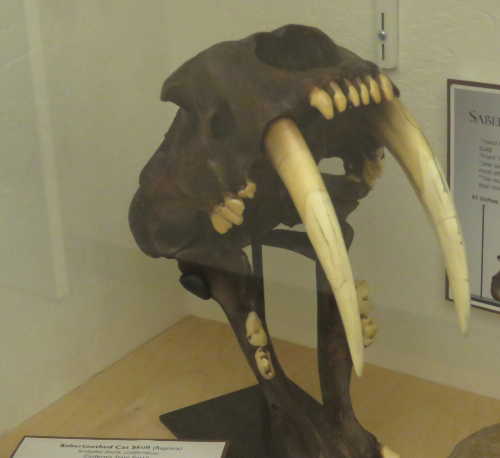
LAKE COUNTY, Calif. – When we hear of a bear or mountain lion sighting here in Lake County, we get excited – but place yourself firmly in your “time machine” and picture a creature such as the saber-toothed cat of yesteryear.
OK, you'd need to travel back farther than yesteryear – more like 15,000 years, and since the saber-toothed cat, Smilodon fatalis (californicus) was around for about 42 million years, that would have placed the saber-toothed cat in the Eocene epoch to the Pleistocene epoch.
According to E. Breck Parkman, RPA, senior state archaeologist, California State Parks, Bay Area and Sonoma-Mendocino Coast Districts who is an award-winning archaeologist with over 30 years of experience, the area in California's North Bay in the late Pleistocene era was "grander than anything imaginable."
He compares the land then “to the famous Serengeti Plains of East Africa as described in early historic times.”
Parkman hypothesized that a great grassy valley lay where the bay is now located, and that there was an array of grazing wildlife, including mammoth, mastodon, camel, horse, bison and other herbivores.
There were also ferocious predators like saber-tooth cat, short-faced bear, lions and more. The flying exotics, such as huge vultures and condors, cast their shadows over the prairie then, as well.
An information board in the Courthouse Museum where the replica skull of the saber-toothed cat is found, states, "The extinction of the saber-toothed cats may have been related to the decrease of the larger animals on which they preyed. There is some evidence that the mastodon was the favorite meal of some later-day species of the saber-toothed cats; both lasted in North America only until the end of the Pleistocene. Saber-toothed cats are the most famous California Ice Age fossil. Smilodon californicus was one of the last surviving members of the formidable felines called saber-toothed cats."
It is believed that the diet of saber-toothed cats also included other enormous herbivores of the era such as rhinos and elephants, when they would pounce upon their prey's throat or abdomen. Their specially adapted long teeth would then pierce blood vessels to hasten the kill- perfect for stabbing and slicing.
According to California's Department of Conservation, the saber-toothed cat fossil became designated as the state fossil in January of 1974. Information found on their www.CA.gov Web site states, "This species was one of the last surviving members of a long ancestry of formidable felines called saber-toothed cats."
Saber-toothed cats were thought to be about the size of today's African lion, but twice as heavy. Sabertooths had relatively light hind limbs, with muscular, well-built and exceedingly powerful front limbs.
Kathleen Scavone, M.A., is a retired educator, potter, writer and author of “Anderson Marsh State Historic Park: A Walking History, Prehistory, Flora, and Fauna Tour of a California State Park” and “Native Americans of Lake County.” She also formerly wrote for NASA and JPL as one of their “Solar System Ambassadors.” She was selected “Lake County Teacher of the Year, 1998-99” by the Lake County Office of Education, and chosen as one of 10 state finalists the same year by the California Department of Education.

 How to resolve AdBlock issue?
How to resolve AdBlock issue? 



